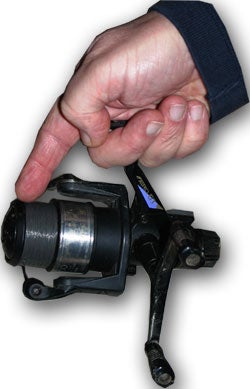Graham Marsden had a dream for a perfect rod. Someone listened and he has now got that rod, the FISHINGmagic.com Concept rod, courtesy of Harrison Advanced Rods . As a float angler I have a dream for a perfect fixed-spool trotting reel. Yes, I know that centre-pins are wonderful. I even use one myself on occasion but I want to be able to cast one-handed, to trot the float under control and retrieve at speed without batting, and all with a truly lightweight, well engineered reel.
There is an opportunity to look at match/trotting reel design that might just produce a winner going well beyond that currently available. Is the design I propose feasible? Is it producible and sellable such that it is worth pursuing? That is for the reel manufacturers to answer. Although much of modern British coarse angling is carp/barbel, feeder, pole oriented there remains a tremendous number of match/pleasure anglers that also floatfish with stick floats, Avons and wagglers. Now for some fixed spool reel history (not too much I promise) The Mitchell 300 appeared around 1948, full bale in 1954 – designed by a man with short fingers – for spinning. The closeness of the spool to the handle of the rod made it ideal for trotting. The automatic opening bale came in the 1950’s (Otomatic) with higher gearing in the 1960’s (the 410), the two being married in the Mitchell Match in the late 1960’s. This reel was phenomenal. Good line lay, and later bale arm rollers meant it sold and sold, and despite being out of production it is still in demand. It is outdated, heavy, prone to tangling, and not especially smooth (some would say rough!). Other manufacturers attempted Mitchell Match copies, notably Daiwa and Ryobi but neither achieved a reel even as good as the original never mind an improvement (too heavy, spools too narrow, spool lip too far from finger). Since then manufacturers like Shimano and Daiwa have led the way with superbly engineered reels but none that can match a Mitchell Match for one-handed trotting despite its shortcomings. Daiwa’s top of the range reels have the right shape, the weight is coming down (2-3 ounces to go) but still need an auto bale arm as described below. Pure Fishing’s relaunch of the Mitchell 300X completely misses the mark – the dimensions are way off. What are the requirements for a perfect one-handed match/trotting reel for 2003? What modern reel features meet them and what innovations might produce a real winner? This is what I want I want an automatic bale that opens at one touch, a good tangle-free bale arm with a twist-free roller that works. I want a retrieve of about 30 – 33 inches (750 – 820 mm) per turn. I want shallow spools – perhaps a selection taking between 100m x 2lbs (0.12mm) to 100m x 6lbs (0.18mm). Overall I want smoothness and reliability. I also want this reel to have the correct dimensions yet weigh about six ounces (170 grams). The correct dimensions for trotting means a reel with which I can easily reach the lip of the spool with my forefinger with the reel stem held between my second and third fingers. My pocket does not stretch to buying every reel that is launched but I spend enough time in tackle shops, at shows and on the riverbank to get some idea of what is about. I have yet to see a reel meeting the above requirements. It is interesting looking at pictures of some well-known anglers trotting with modern reels to see how they are trying to overcome what are fundamental design errors that prevent them from controlling the line easily (usually holding the reel stem between their third and little fingers). I currently use Mitchell Matches but these are prone to tangles, have a poor bale roller, and wear out quickly, becoming noisy. It is interesting to see that John Allerton continues to use these reels but with a modification that brings the spool lip even closer to his finger by somehow bending the reel stem. I have tried some Shimano 1000 GTMs which are a little on the small side yet fantastically engineered – alter the dimensions slightly, get the weight down and add an automatic bale arm and you are almost there. The bigger Shimano reels are okay for feeder fishing but just too big for trotting. Part of the problem comes down to the old ‘one size fits all’ philosophy. Ask a car designer what size of person he has designed a car for and he or she will tell you between 5 feet and 6 feet tall. Ask someone who is 4’9″ or 6′ 9″ how easy it is to find a comfortable car to drive and prepare for some abusive language. Add to the problem that the vast majority of reels are designed for spinning, not trotting, and it becomes easy to see why it might be difficult to get the dimensions right. There is also a trend for the spool to become longer and thinner as a result of the change to skirted spools. Let’s take each design point in turn Weight Spool shape Bale arm Reel stem Drag Gearing and bearings Handle Overall If someone is prepared to take this seriously then I hope they will look at how a reel is used because my observation is that there are an awful lot of float anglers looking for a reel that is ten times better than the old Mitchell Match but with those features that made it a million seller. Don’t all beat a path to my door at once! |
Welcome!Log into your account














